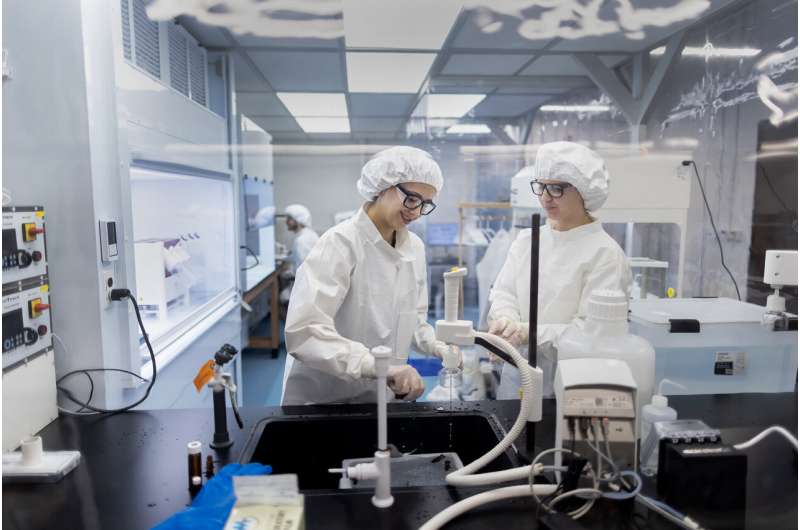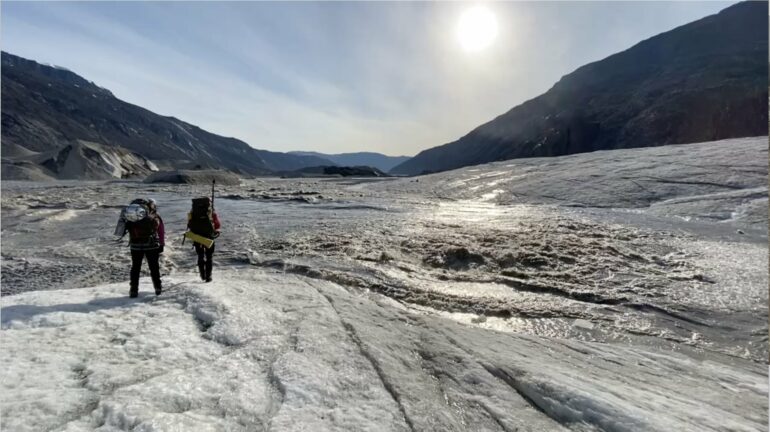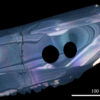Perched next to a river near a glacier’s edge in Greenland, Penn biogeochemist Jon Hawkings and Jack Murphy, senior research coordinator in Hawkings’ lab, scooped up samples of frigid meltwater, careful to seal the bottles quickly to minimize any chance of contamination. The two spent nearly a month in Greenland this past summer. The fieldwork, while scenic, isn’t glamorous. “You’re standing in front of a massive glacier submerging your hands in zero degrees Celsius water; it’s freezing and windy and dusty,” Murphy says. “We have to get creative to get clean samples.”
Back in Hawkings’ lab at Penn—the BiCycles Lab, short for biogeochemical cycles—these collections of glacial melt offer the scientists a window into a variety of geological, biological, and chemical processes that impact everything from fish health to climate change.
“I work on the cycling of elements through Earth’s systems,” says Hawkings, an assistant professor who joined the School of Arts & Sciences’ Department of Earth and Environmental Science in 2021. “My main research interest is in polar and alpine regions and my specialty is glaciers: the role they play in cycling these elements, as well as glaciers as biomes, harboring life in their own right.”
Until relatively recently, most scientists overlooked glaciers’ considerable dynamism, an area around which Hawkings shaped his career. Blending fieldwork and laboratory investigations, his studies have taken him to a variety of locations, including Greenland, Norway, Antarctica, Patagonia, and the Himalayas. The insights he and his colleagues are bringing back from these remote locales are reshaping how scientists understand the contributions of these icy environments to regional and global systems.
Living glaciers
On their face, glaciers and ice sheets—defined as masses of glacial ice that cover more than 20,000 square miles—do appear somewhat static, devoid of life. “That was the classic view of these environments, of places like Greenland and Antarctica: that ice is cold, ice is frozen, that there’s not much life there, that they’re not very dynamic,” says Hawkings.
And while in most cases, no immediately recognizable critters dwell on the surface of or within glaciers, hardy algae and microbes do render these spaces very much alive.
“In many of these locations there is liquid water at the bed of the ice sheets, like in the Antarctic,” Hawkings says. “More than 650 subglacial lakes have been identified using geophysical surveys, and some of these lakes are connected to each other.”
It’s only in the last decade that scientists have managed to access the water in these subglacial lakes. One research partnership with which Hawkings is connected uses heavy equipment to cleanly drill through the thick ice and sample the deep waters. “We can see what’s living there and what the composition of the water is and what that tells us about how the water is flowing underneath the ice,” he says.
In January, Hawkings contributed to a publication in the journal ISME Communications that reported on the microbes living in a lake beneath the West Antarctic Ice Sheet, finding that these subglacial aquatic communities appeared to be linked and to be exchanging microbial life, as well as sediment and nutrients, with one another. It’s an entire complex, connected ecosystem that was previously unknown to science.

Doctoral student Amina Youssef and postdoc Eva Doting work to clean equipment in the BiCycles Lab, located in Penn’s Laboratory for Research on the Structure of Matter. © Eric Sucar
Ice in motion
In addition to harboring life, glaciers also move, albeit fairly slowly, says Hawkings. They are sometimes referred to as “ice rivers.” As they flow, the ice can act like sandpaper, grinding up the bedrock upon which they sit. “Anything that’s in that bedrock can become mobilized and, if it’s reactive, will dissolve into water,” he says.
Hawkings has studied how this glacier-powered erosion contributes to the release of a variety of elements. A paper published in November in the journal Global Biogeochemical Cycles, for example, revealed a relationship between silicon and iron released by glaciers into Patagonian fjords.
Hawkings and his lab group are also turning attention to the role of glaciers in propagating toxins like mercury into aquatic ecosystems. While large amounts of mercury finds its way there due to industrial activities, in a 2021 Nature Geosciences paper, Hawkings and colleagues pointed to naturally occurring mercury from the ice sheet bed as another potentially important source, based on data from the Greenland Ice Sheet.
And they believe the same may be true in other areas around the globe. In certain Norwegian fjords, for instance, consuming fish caught there is banned due to their unusually high mercury levels.
“We predict that some of this mercury is coming from the glaciers,” says Amina Youssef, a first-year Presidential Ph.D. fellow in Hawkings’ lab. “The more rock erodes at the glacier-rock interface, the more the trapped, rock-bound mercury may enter the aquatic system.”
Youssef joined Hawkings in the field in Norway this past summer to collect samples that delve deeper into this question, including how climate change may contribute to this mercury release.
“Our hypothesis is that as the climate warms there may be a positive feedback loop that increases erosion and increases this expulsion of mercury from glaciers,” Youssef says.
It’s also possible that the reality is even more complex, says postdoc Eva Doting, who joined the Hawkings lab last month as a postdoctoral researcher following graduate work in Denmark. “More melt could be causing more mercury to be released, or it could mean the mercury that is released is diluted down. We want to know what’s happening now and how that will change with the changing climate.”

Jorge Montt Glacier in Chilean Patagonia is another site where Hawkings has conducted fieldwork. The glacier has retreated nearly 10 kilometers since 1975. © Jon Hawkings
Climate and environment connections
Though glaciers cover just 10% of Earth’s land surface, Hawkings sees them as a harbinger of the environmental effects of climate change.
“Glaciers are barometers of climate change,” he says. Their concentration in polar and alpine regions also means they are subject to the rapid warming occurring there. Temperatures at the poles are rising four or more times faster than the global average.
“So, these aren’t inconsequential systems,” Hawkings says, “and because they’re changing so, so rapidly we really need to understand how they might continue to respond to the climate change that is going to occur over the next 10, 20, or 100 years.”
In addition to forecasting the future, studying glaciers can reveal the hidden history of the planet. The last glacial maximum, when almost 30% of Earth’s land surface was covered in ice, was “only” around 21,000 years ago. “In geological timescales, that’s a very short time,” Hawkings says.
Much of what emerges from melting glaciers is no surprise: water. The elements under study by Hawkings and his group are typically present in tiny amounts in their samples. That makes analytical precision and preventing contamination of the utmost importance. A newly built clean room in the Laboratory for Research on the Structure of Matter grants the BiCycles Lab a high-tech environment to pursue these investigations, complete with a pressurized workspace, filtered air hoods, required gowns and booties to minimize the risk of contamination, and a powerful mass spectrometer capable of identifying miniscule traces of elements in a given sample.
Not only can the lab’s tools and techniques be used to explore extreme environments but environments closer to home as well. Given problems of toxicity from lead and other heavy metals in homes and environments in Philadelphia and other local communities, the group hopes to apply their knowledge and cutting-edge techniques to help educate residents about potential hazards.
“We’d like to make high-level testing available to the community since our facilities can do testing that others can’t or is quite expensive,” says Murphy, who performed similar work in Trenton during his graduate work.
With the lab growing and collaborations established worldwide, Hawkings is eager to generate more knowledge and impact, locally and globally.
“So much of this research in elemental mobilization and global systems just wasn’t done even a decade ago,” he says. “It’s a quite exciting area to be working in.”
More information:
Christina L. Davis et al, Biogeochemical and historical drivers of microbial community composition and structure in sediments from Mercer Subglacial Lake, West Antarctica, ISME Communications (2023). DOI: 10.1038/s43705-023-00216-w
Hong Chin Ng et al, Benthic Dissolved Silicon and Iron Cycling at Glaciated Patagonian Fjord Heads, Global Biogeochemical Cycles (2022). DOI: 10.1029/2022GB007493
Provided by
University of Pennsylvania
Citation:
From glacier ice, a wealth of scientific data (2023, February 14)



